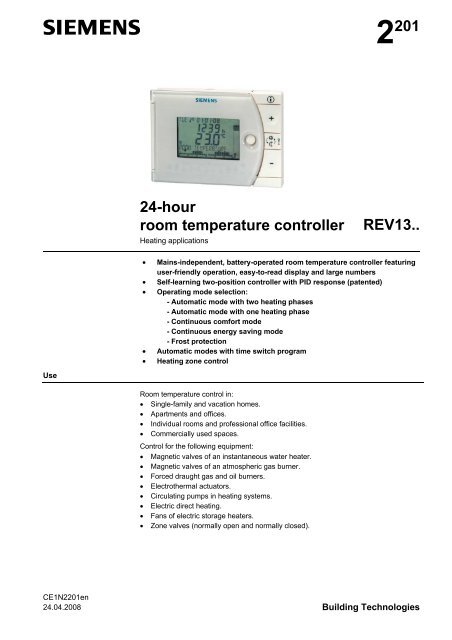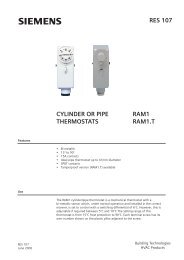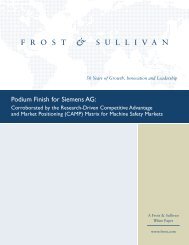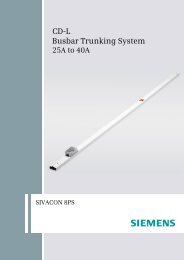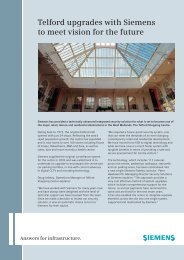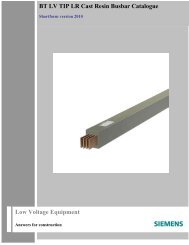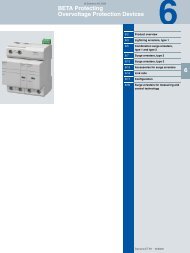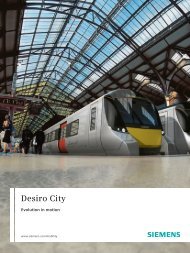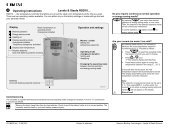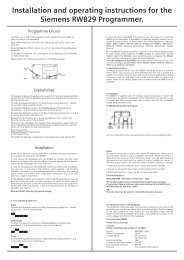2201 24-hour room temperature controller REV13.. - Industry UK ...
2201 24-hour room temperature controller REV13.. - Industry UK ...
2201 24-hour room temperature controller REV13.. - Industry UK ...
Create successful ePaper yourself
Turn your PDF publications into a flip-book with our unique Google optimized e-Paper software.
s2 201<strong>24</strong>-<strong>hour</strong><strong>room</strong> <strong>temperature</strong> <strong>controller</strong>Heating applications<strong>REV13.</strong>.• Mains-independent, battery-operated <strong>room</strong> <strong>temperature</strong> <strong>controller</strong> featuringuser-friendly operation, easy-to-read display and large numbers• Self-learning two-position <strong>controller</strong> with PID response (patented)• Operating mode selection:- Automatic mode with two heating phases- Automatic mode with one heating phase- Continuous comfort mode- Continuous energy saving mode- Frost protection• Automatic modes with time switch program• Heating zone controlUseRoom <strong>temperature</strong> control in:• Single-family and vacation homes.• Apartments and offices.• Individual <strong>room</strong>s and professional office facilities.• Commercially used spaces.Control for the following equipment:• Magnetic valves of an instantaneous water heater.• Magnetic valves of an atmospheric gas burner.• Forced draught gas and oil burners.• Electrothermal actuators.• Circulating pumps in heating systems.• Electric direct heating.• Fans of electric storage heaters.• Zone valves (normally open and normally closed).CE1N<strong>2201</strong>en<strong>24</strong>.04.2008 Building Technologies
Function• PID control with self-learning or selectable switching cycle time• 2-point control• <strong>24</strong>-<strong>hour</strong> time switch• Remote control• Preselected <strong>24</strong>-<strong>hour</strong> operating modes• Override function• Party mode• Frost protection mode• Information level to check settings• Reset function• Sensor calibration• Minimum limitation of setpoint• Synchronization to radio time signal from Frankfurt, Germany (REV13DC)Type summary<strong>24</strong>-<strong>hour</strong> <strong>room</strong> <strong>temperature</strong> <strong>controller</strong><strong>24</strong>-<strong>hour</strong> <strong>room</strong> <strong>temperature</strong> <strong>controller</strong> withreceiver for time signal from Frankfurt, Germany (DCF77)REV13REV13DCOrderingPlease indicate the type number as per the "Type summary" when ordering.DeliveryThe <strong>controller</strong> is supplied with batteries.Mechanical designPlastic casing with an easy-to-read display and large numbers, easily accessibleoperating elements, and removable base.The housing contains the <strong>controller</strong>'s electronics, DIP switches, and the relay withpotential-free changeover contact. The easily accessible battery compartment allows foreasy exchange of two 1.5 V alkaline batteries, type AAA.The base with terminal block provides lots of space to connect the wires.Display and operatingelements2 / 12Siemens Room <strong>temperature</strong> <strong>controller</strong> <strong>REV13.</strong>. CE1N<strong>2201</strong>enBuilding Technologies <strong>24</strong>.04.2008
1 DisplayWeekday (max. 3 spaces)Heating mode0 4 8 12 16 20 <strong>24</strong><strong>24</strong> <strong>hour</strong> timeframeSwitching pattern withflashing time cursorTime signal from Frankfurt Info Information displayWithout language selectionSetpoint for frost protectionmodehTime unitSetpoint for comfort mode °C / °F Temperature unit °C or °FSetpoint for remote controlRoom <strong>temperature</strong>AlarmSetpoint for energy savingmodeChange batteryParty mode activeHeating / pump onRemote control activeDate (day - month - year)Time of dayRoom <strong>temperature</strong>(measured)Clear text display line(max. 18 spaces)Operating mode(operating mode selector,see below)2 Operating mode selectorAutomatic <strong>24</strong>-<strong>hour</strong> mode with two heating phasesAutomatic <strong>24</strong>-<strong>hour</strong> mode with one heating phaseContinuous comfort mode (= continuous comfort <strong>temperature</strong>)Continuous energy saving mode (= continuous energy saving<strong>temperature</strong>)Frost protection mode ( = continuous frost protection <strong>temperature</strong>)3 INFOPressing the Info button once illuminates the display. Illuminationautomatically turns off after a short period of time.Pressing the Info button again activates the information display:The unit first displays queued error messages followed by importantinformation (e.g. time switch programs, etc.).is lit.4 Plus buttonIncrease values, set time, or make a selection.3 / 12Siemens Room <strong>temperature</strong> <strong>controller</strong> <strong>REV13.</strong>. CE1N<strong>2201</strong>enBuilding Technologies <strong>24</strong>.04.2008
5 Override button / party modeIn the time switch program, this button allows you to quickly change from theactive <strong>temperature</strong> level to the next and back.Thus, you can quickly change to energy saving <strong>temperature</strong> when you leavethe apartment for a short period of time, thus saving energy.The display indicates the change. It is valid only until the next switching time.Activate party mode: Press the button for 3 seconds.Party mode is available only in operating modes and . In partymode, the <strong>controller</strong> controls to a freely selectable <strong>temperature</strong> for a freelyselectable period of time.In party mode, symbolis displayed along with the end of party mode.6 Minus buttonDecrease values, set time, or make a selection.7 Program selection sliderRUNTime.Day – Month – Year (2 spaces for day, month, and year).Start time 1End 1User-specific settings for 1 st heating phase forautomatic mode with 2 heating phases .Start time 2End 2User-specific settings for 2 nd heating phase forautomatic mode with 2 heating phases .Start timeEndUser-specific settings forautomatic mode with 1 heating phase .Comfort <strong>temperature</strong> for the automatic mode time switches A and B.Energy saving <strong>temperature</strong> for the automatic mode time switches A and B.Temperature setpoint at active remote control.RUNSlider position RUN allows for closing the cover.4 / 12Siemens Room <strong>temperature</strong> <strong>controller</strong> <strong>REV13.</strong>. CE1N<strong>2201</strong>enBuilding Technologies <strong>24</strong>.04.2008
Operating modes<strong>24</strong>-<strong>hour</strong> operation withtime switch programExample A with2 heating phasesThe <strong>controller</strong> offers the two time switch programs and .Enter a start time and end time for each heating phase. The comfort <strong>temperature</strong>setpoint can be freely entered and is the same for both heating phases. Between theheating phases the <strong>controller</strong> always switches to the same, freely selectable energysaving <strong>temperature</strong> setpoint.°C2<strong>2201</strong>816Heatingphase 1Heatingphase 2<strong>2201</strong>Z0206 08 17 22 hContinuous operatingmodesThe <strong>controller</strong> also offers the three 3 continuous modesenergy saving mode andfrost protection mode.comfort mode,SetpointsYou can freely adjust <strong>temperature</strong> setpoints.Setting range for all setpoints without setpoint limitation 3…35 °C.Setting range for all setpoints with setpoint limitation 16…35 °C.Factory settingFactory settings: Heating,,20 °C16 °C8 °C12 °CFactory settings: Switching timesA1 A2 A3 A406:00 08:00 17:00 22:00B1B207:00 23:005 / 12Siemens Room <strong>temperature</strong> <strong>controller</strong> <strong>REV13.</strong>. CE1N<strong>2201</strong>enBuilding Technologies <strong>24</strong>.04.2008
Remote controlUse a suitable remote control unit to activate the "Remote control" <strong>temperature</strong>setpoint in the <strong>controller</strong>. Changeover takes place by making a potential-free contactconnected to terminals T1 and T2.A flashing symbol indicates active remote control mode.After the contact opens, the previously set operating mode is reactivated.Operation according to <strong>controller</strong> settingT1Temperature setpoint “remote control“activeT1T22252Z05, , , ,T22252Z06Suitable remote control units are:Telephone modem, manual switch, window contact, presence detector, central unit, etc.Enter <strong>temperature</strong> foractive remote controlYou can freely select the <strong>temperature</strong> for active remote control. Activating remote controlimmediately enables control to the remote control <strong>temperature</strong> regardless of the currentlyactive operating mode. When you deactivate remote control, the <strong>controller</strong> returns to theset operating mode.A flashing symbol indicates active remote control mode.Proceed as follows to enter your settings:Set slider to <strong>temperature</strong> for active remote control: Press or to set thedesired <strong>temperature</strong>.RUN Return the slider to position RUN.Technical featuresDIP switchesON / OFF 1 2 3 4 5 6SeeABCDEFSensor calibration OnSensor calibration OffSetpoint limitation 16…35 °CSetpoint limitation 3…35 °CTemperature display °FTemperature display °CPID self-learningPID 6PID122-pointQuartzRadio clockDIP switch resetON1 2 3 45 6 7 8 92211Z32After you change one or several DIP switch positions, you must press the DIP switch resetbutton to reset the DIP switch. Otherwise, the previous setting remains active!Factory setting: All DIP switches toOFF6 / 12Siemens Room <strong>temperature</strong> <strong>controller</strong> <strong>REV13.</strong>. CE1N<strong>2201</strong>enBuilding Technologies <strong>24</strong>.04.2008
A Sensor calibration:DIP switch 1B Setpoint limitation:DIP switch 2C Temperature display in°C or °F:DIP switch 3D Control behavior:DIP switches 4 and 5E Radio clock:DIP switch 10If the displayed <strong>room</strong> <strong>temperature</strong> does not match the measured <strong>room</strong> <strong>temperature</strong>, the<strong>temperature</strong> sensor can be recalibrated.Set DIP switch to ON and press the DIP switch reset button:CAL symbol is displayed. The currently measured <strong>temperature</strong> flashes.Press or to recalibrate by max. ± 5 °C.Set DIP switch to OFF and press the DIP switch reset button to save the settings.The minimum setpoint limitation of 16 °C prevents undesired heat transfer to neighboringspaces in buildings featuring several heating zones.DIP switch ON: Setpoint limitation 16…35 °C.DIP switch OFF: Setpoint limitation 3…35 °C (factory setting).Press the DIP switch reset button to save the settings.DIP switch ON: Temperature display in °F.DIP switch OFF: Temperature display in °C (factory setting).Press the DIP switch reset button to save the settings.The REV13… is a two-position <strong>controller</strong> with PID control. The <strong>room</strong> <strong>temperature</strong> iscontrolled through cyclic switching of an actuating unit.DIP switches 4 ON and 5 ON: PID self-learningAdaptive control for all applications.DIP switches 4 ON and 5 OFF: PID 6Fast controlled system for applications in locations withlarge <strong>temperature</strong> deviations.DIP switches 4 OFF and 5 ON: PID 12Normal controlled system for applications in locations withnormal <strong>temperature</strong> deviations.DIP switches 4 OFF and 5 OFF: 2-pointFor complex controlled systems, simple two-position <strong>controller</strong> with0.5 °C switching differential (factory setting).Press the DIP switch reset button to save the settings.Only applicable to REV..DC (with integrated DCF77 receiver to receive time signal fromFrankfurt, Germany)!DIP switch ON: Clock run by <strong>controller</strong>-internal quartz.DIP switch OFF:Time signal DCF77 from Frankfurt, Germany.Press the DIP switch reset button to save the settings.Noteon synchronizationNoteon receptionNo receptionF DIP switch resetON1 2 3 45 6 7 8 92211Z32During startup, REV..DC synchronizes automatically to the time signal (DCF77) fromFrankfurt, Germany. Synchronization takes max. 10 minutes. Synchronization restartseach time you press the button or move the program selection slider from the RUNposition during these 10 minutes. Siemens recommends to set the desired settings uponstartup, install the REV..DC in the desired location, and not carry out any actions on theREV..DC for the next 10 minutes.In normal operation, the REV..DC synchronizes to the radio clock every day at 3:10 a.m.The time signal from Frankfurt is modulated to a radio signal. The reception of this radiosignal depends on the distance to Frankfurt, atmospheric conditions as well as thelocation where the REV..DC is installed. Siemens cannot guarantee that the REV..DCcan receive the time signal from Frankfurt at any time and any place.The radio clock symbol is deactivated and an error message is displayed if the clock was notable to synchronize the time for 7 consecutive days. The <strong>controller</strong> then runs on the internalquartz.After you change one or several DIP switch positions, you must press the DIP switchreset button to reset the DIP switch.Otherwise, the previous setting remains active!7 / 12Siemens Room <strong>temperature</strong> <strong>controller</strong> <strong>REV13.</strong>. CE1N<strong>2201</strong>enBuilding Technologies <strong>24</strong>.04.2008
Access to the expert levelSet the program selection slider to RUN. Press and simultaneously for 3 seconds, release the buttons, andwithin 3 seconds press and hold down and simultaneously for 3 seconds, release , and press for another3 seconds. This releases the engineering settings. is displayed.The display first shows language selection with Code 00. Press the buttons or to navigate the settings.Confirm settings by pressing .Press the operating mode selector to exit the engineering settings.Code listFunction block Code Name Factory setting Your setting00 Language EnglishBasic settings 01 Sensor calibration off02 Switching differential 2-point 0.5 °CLCDoptimizationClock settingsNote 1:Note 2:Note 3:10 Illumination time 10 seconds11 Background brightness 012 Contrast 030Time zoneDeviation from time signal in Frankfurt 0 <strong>hour</strong>s(Central European Time CET) (see Note 1)31 Start of daylight saving time (see Note 2) March 31 (03-31)32 End of daylight saving time (see Note 3) October 31 (10-31)This entry has no effect if the radio clock either is inactive or not available.The time signal received from Frankfurt is shifted by the value set in Code 30 (time zone)if the radio clock is active.The time is always changed over at 2 a.m. on the Sunday preceding the set date if thereis no radio clock or if it is inactive. The time change is shifted by the value set in Code 30(time zone) when the radio clock is active.The time is always changed over at 3 a.m. on the Sunday preceding the set date if thereis no radio clock or if it is inactive.Functional checka) Check the display. If there is no display, check insertion and function of the batteries.b) Operating mode “Continuous comfort mode“ , read displayed <strong>temperature</strong>.c) Set the <strong>temperature</strong> setpoint higher than the displayed <strong>room</strong> <strong>temperature</strong> (see operatinginstructions).d) The relay and, as a result, the actuating device must switch at the latest after one minute.Symbol ▲ is displayed. If not displayed:• Check actuating device and wiring.• It is possible that in heating mode the <strong>room</strong> <strong>temperature</strong> is higher than the set<strong>temperature</strong> setpoint.e) Set the <strong>temperature</strong> setpoint for operating mode “Continuous comfort mode“ to thedesired value.f) Select the desired operating mode.8 / 12Siemens Room <strong>temperature</strong> <strong>controller</strong> <strong>REV13.</strong>. CE1N<strong>2201</strong>enBuilding Technologies <strong>24</strong>.04.2008
ResetUser-defined settings:, and simultaneously for 3 seconds:This resets all <strong>temperature</strong> and time settings of the program selection slider to defaultvalues (see also "Factory settings" in the operating instructions). The expert settingsremain unchanged.The clock starts at 12 p.m., the date on 01-01-08 (01 - January - 2008).During the reset, all display fields are lit and can be checked accordingly.All user-defined settings plus expert settings:ON2211Z321 2 3 4Press the DIP switch reset button, and simultaneously for5 seconds:After the reset, all factor settings are reloaded. This applies to the program selectionslider as well as to the expert settings.5 6 7 8 9Engineering• Mount the <strong>room</strong> <strong>temperature</strong> <strong>controller</strong> in the main living <strong>room</strong>.• Select the mounting place so that the sensor can acquire the air <strong>temperature</strong> in the<strong>room</strong> as accurately as possible and without being influenced by solar radiation orother heat or refrigeration sources.• Mounting height is approx. 1.5 m above the floor.• You can mount the unit on most commercially available recessed conduit boxes ordirectly on the wall.Mounting andinstallationCommissioningNotes• Begin installation by first attaching and wiring the base. You can mount the base onmost commercially available recessed conduit boxes or directly on the wall. Theninsert the <strong>controller</strong> from top to bottom into the base.For more information, see the installation instructions supplied with the unit.• Comply with all local regulations on electrical installation.• Wire separately the remote control contact T1 / T2 using a separate, shielded cable.• Remove from the batteries the battery transit tab designed to prevent prematureactivation of the unit: Select desired language by or . Confirm by .• You can change the control characteristics using the DIP switch on the rear of theunit.• Set any thermostatic radiator valves to their fully open position, if present in thereference <strong>room</strong>.• Recalibrate the <strong>temperature</strong> sensor (see "Sensor calibration") if the displayed <strong>room</strong><strong>temperature</strong> does not match the <strong>room</strong> <strong>temperature</strong> measured.This is a software class A <strong>controller</strong> designed for use at a normal degree of pollution.9 / 12Siemens Room <strong>temperature</strong> <strong>controller</strong> <strong>REV13.</strong>. CE1N<strong>2201</strong>enBuilding Technologies <strong>24</strong>.04.2008
Technical dataGeneral unit dataStandardsProduct safetyEnvironmental conditionsWeightColorSizePowerBatteries (alkaline AAA)LifeBackup of clock when changing battery(all other data remain in EEPROM)Switching capacity of relayVoltageCurrentDC 3 V2 x 1,5 VCa. 2 yearsMax. 1 minAC <strong>24</strong>…250 V0.1…6 (2.5) AProtection class II as per EN 60 730-1Sensing elementMeasuring rangeTime constantSetpoint setting rangesAll <strong>temperature</strong> settings 3…35 °CResolution for settings and displaysSetpointsSwitching timesActual value measurementActual value displayTime displayCE conformityElectromagnetic compatibilityLow voltage directiveC-tickAutomatic electrical controls for householdand similar useElectromagnetic compatibilityImmunityEmissionsDegree of protectionOperationClimatic conditionsTemperatureHumidityStorage and transportClimatic conditionsTemperatureHumidityMechanical conditionsExcl. packagingHousingBaseHousing with baseNTC 10 kΩ ±1 % at 25 °C0…50 °CMax. 10 min0.2 °C10 min0.1 °C0.2 °C1 min2004/108/EEC2006/95/ECN474EN 60 730-1EN 61000-6-2EN 61000-6-3IP203K3 as per IEC 60 721-35...40 °C< 85 % r.h.2K3 as per IEC 60 721-3-25...70 °C< 93 % r.h.2M2 as per IEC 60 721-30.<strong>24</strong> kgRAL9003 signal whiteRAL7038 gray94 x 130 x 30 mm10 / 12Siemens Room <strong>temperature</strong> <strong>controller</strong> <strong>REV13.</strong>. CE1N<strong>2201</strong>enBuilding Technologies <strong>24</strong>.04.2008
Connection diagramsL2252A02DC 3 VT1 T2 L2LL1N1AC <strong>24</strong>...250 VS1NNY1M1REV13 / REV13DCL Phase, AC <strong>24</strong> … 250 V S1 Remote control unit (potential-free)L1 N.O. contact,T1 Remote control signalAC <strong>24</strong> …250 V / 6 (2.5) AL2 N.C. contact,T2 Remote control signalAC <strong>24</strong> … 250 V / 6 (2.5) AM1 Circulating pump Y1 Actuating deviceN1 REV13… <strong>controller</strong>Application examplesN1TTTF1F2TN1F2TF1TY2M1Y2M1Instantaneous water heater2252S01Atmospheric gas burner2252S02N1TN1TN1TY1M1Y3Y42252S032252S04Zone valveCirculating pump with precontrol bymanual mixing valveF1 Thermal reset limit thermostat Y1 3-port valve with manual adjustmentF2 Manual reset safety limit thermostat Y2 Magnetic valveM1 Circulating pump Y3 Three-port valve with actuatorN1 <strong>REV13.</strong>. <strong>room</strong> <strong>temperature</strong> <strong>controller</strong> Y4 Two-port valve with actuator11 / 12Siemens Room <strong>temperature</strong> <strong>controller</strong> <strong>REV13.</strong>. CE1N<strong>2201</strong>enBuilding Technologies <strong>24</strong>.04.2008
Dimensions1<strong>24</strong>,59082563056Ø 6013016,21383,52206M0112 / 12©2008 Siemens Switzerland Ltd Subject to changeSiemens Room <strong>temperature</strong> <strong>controller</strong> <strong>REV13.</strong>. CE1N<strong>2201</strong>enBuilding Technologies <strong>24</strong>.04.2008


